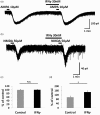Interferon-gamma potentiates NMDA receptor signaling in spinal dorsal horn neurons via microglia-neuron interaction
- PMID: 27094552
- PMCID: PMC4956380
- DOI: 10.1177/1744806916644927
Interferon-gamma potentiates NMDA receptor signaling in spinal dorsal horn neurons via microglia-neuron interaction
Abstract
Background: Glia-neuron interactions play an important role in the development of neuropathic pain. Expression of the pro-inflammatory cytokne →cytokine Interferon-gamma (IFNγ) is upregulated in the dorsal horn after peripheral nerve injury, and intrathecal IFNγ administration induces mechanical allodynia in rats. A growing body of evidence suggests that IFNγ might be involved in the mechanisms of neuropathic pain, but its effects on the spinal dorsal horn are unclear. We performed blind whole-cell patch-clamp recording to investigate the effect of IFNγ on postsynaptic glutamate-induced currents in the substantia gelatinosa neurons of spinal cord slices from adult male rats.
Results: IFNγ perfusion significantly enhanced the amplitude of NMDA-induced inward currents in substantia gelatinosa neurons, but did not affect AMPA-induced currents. The facilitation of NMDA-induced current by IFNγ was inhibited by bath application of an IFNγ receptor-selective antagonist. Adding the Janus activated kinase inhibitor tofacitinib to the pipette solution did not affect the IFNγ-induced facilitation of NMDA-induced currents. However, the facilitatory effect of IFNγ on NMDA-induced currents was inhibited by perfusion of the microglial inhibitor minocycline. These results suggest that IFNγ binds the microglial IFNγ receptor and enhances NMDA receptor activity in substantia gelatinosa neurons. Next, to identify the effector of signal transmission from microglia to dorsal horn neurons, we added an inhibitor of G proteins, GDP-β-S, to the pipette solution. In a GDP-β-S-containing pipette solution, IFNγ-induced potentiation of the NMDA current was significantly suppressed after 30 min. In addition, IFNγ-induced potentiation of NMDA currents was blocked by application of a selective antagonist of CCR2, and its ligand CCL2 increased NMDA-induced currents.
Conclusion: Our findings suggest that IFNγ enhance the amplitude of NMDA-induced inward currents in substantia gelatinosa neurons via microglial IFNγ receptors and CCL2/CCR2 signaling. This mechanism might be partially responsible for the development of persistent neuropathic pain.
Keywords: CCR2; NMDA receptor; Neuropathic pain; dorsal horn; interferon-gamma; microglia; patch-clamp recording; spinal cord.
© The Author(s) 2016.
Figures








Similar articles
-
Enhancement by interleukin-1β of AMPA and NMDA receptor-mediated currents in adult rat spinal superficial dorsal horn neurons.Mol Pain. 2013 Mar 28;9:16. doi: 10.1186/1744-8069-9-16. Mol Pain. 2013. PMID: 23537341 Free PMC article.
-
Leukotriene enhances NMDA-induced inward currents in dorsal horn neurons of the rat spinal cord after peripheral nerve injury.Mol Pain. 2015 Sep 9;11:53. doi: 10.1186/s12990-015-0059-5. Mol Pain. 2015. PMID: 26353783 Free PMC article.
-
Minocycline, a microglial inhibitor, blocks spinal CCL2-induced heat hyperalgesia and augmentation of glutamatergic transmission in substantia gelatinosa neurons.J Neuroinflammation. 2014 Jan 10;11:7. doi: 10.1186/1742-2094-11-7. J Neuroinflammation. 2014. PMID: 24405660 Free PMC article.
-
Dorsal horn alpha-amino-3-hydroxy-5-methyl-4-isoxazolepropionic acid receptor trafficking in inflammatory pain.Anesthesiology. 2010 May;112(5):1259-65. doi: 10.1097/ALN.0b013e3181d3e1ed. Anesthesiology. 2010. PMID: 20395828 Free PMC article. Review.
-
Chemokines and pain mechanisms.Brain Res Rev. 2009 Apr;60(1):125-34. doi: 10.1016/j.brainresrev.2008.12.002. Epub 2008 Dec 25. Brain Res Rev. 2009. PMID: 19146875 Free PMC article. Review.
Cited by
-
Interferon-gamma and neuropathy: balance between pain and neuroprotection.Neural Regen Res. 2022 Dec;17(12):2700-2701. doi: 10.4103/1673-5374.339484. Neural Regen Res. 2022. PMID: 35662216 Free PMC article. No abstract available.
-
Suppression of Superficial Microglial Activation by Spinal Cord Stimulation Attenuates Neuropathic Pain Following Sciatic Nerve Injury in Rats.Int J Mol Sci. 2020 Mar 30;21(7):2390. doi: 10.3390/ijms21072390. Int J Mol Sci. 2020. PMID: 32235682 Free PMC article.
-
The Elevated Serum Level of IFN-γ in Patients with Failed Back Surgery Syndrome Remains Unchanged after Spinal Cord Stimulation.Dis Markers. 2019 Jan 14;2019:2606808. doi: 10.1155/2019/2606808. eCollection 2019. Dis Markers. 2019. PMID: 30755780 Free PMC article.
-
Excitatory and inhibitory neuronal signaling in inflammatory and diabetic neuropathic pain.Mol Med. 2023 Apr 17;29(1):53. doi: 10.1186/s10020-023-00647-0. Mol Med. 2023. PMID: 37069517 Free PMC article. Review.
-
Reversal of TRESK Downregulation Alleviates Neuropathic Pain by Inhibiting Activation of Gliocytes in the Spinal Cord.Neurochem Res. 2017 May;42(5):1288-1298. doi: 10.1007/s11064-016-2170-z. Epub 2017 Feb 3. Neurochem Res. 2017. PMID: 28160200
References
Publication types
MeSH terms
Substances
LinkOut - more resources
Full Text Sources
Other Literature Sources
Molecular Biology Databases

